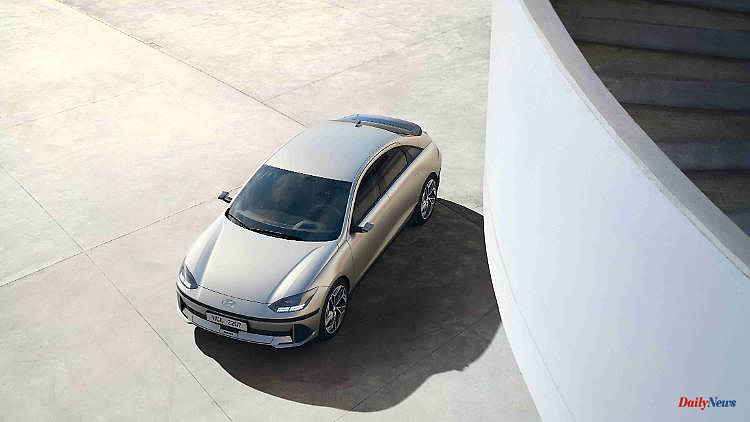After the successful mid-range SUV Ioniq 5, Hyundai will soon launch the technically identical Ioniq 6. In the case of the luxury sedan, however, the designers opted for flowing and round instead of edgy.
With the Ioniq 5, Hyundai has undoubtedly made a hit. The mid-range SUV not only electrifies customers with its cool, angular design, but also with its superior technology. The 800-volt architecture enables the shortest possible charging times, none of its European competitors manages to top up a good 300 "new" kilometers within 18 minutes.
And otherwise the Ioniq 5 seems to be well received. This is underlined by the more than 16,000 units that Hyundai has been able to sell in Germany alone since its debut a year and a half ago. As a brand, Hyundai is already in third place in Germany for new electric vehicle registrations, behind VW and Tesla. The market share is currently 8.2 percent.
Whether it continues to grow depends not least on the future products that Hyundai wants to bring to the streets in the next few years. The first candidate is the Ioniq 6, an almost 4.90 meter long luxury class sedan and at the same time the largest car from Hyundai. If you now think that you might see a certain similarity to the Ioniq 5 in the design, you will be disappointed. Two technically almost identical vehicles from one brand could hardly be more different. While the designers of the Ioniq 5 focus on profile and edges, the Ioniq 6 comes across as flowing and round. Especially the rear, always a big challenge, polarizes.
Under the body is the well-known group platform E-GMP (Electric Global Modular Platform). So far, Hyundai is the only volume manufacturer to use an 800-volt architecture. The twice as high voltage - 400 volts is usual in the industry - enables higher charging currents and thus shorter charging times. Hyundai also promises up to 240 kW DC charging power for the Ioniq 6. In the best case, the battery can be brought from 10 to 80 percent of its capacity in just over 15 minutes, a record in the segment.
The entry-level version of the Ioniq 6 has a 53 kWh battery in the floor, the motor has an output of 111 kW/151 hp and drives the rear axle. Not least thanks to its sophisticated aerodynamics, the sedan is said to achieve a WLTP range of 400 kilometers. However, the majority of buyers will probably choose the 77.4 kWh battery. Although this sends the price up significantly, it also increases performance and range. 239 kW/325 hp go to all four wheels. The Ioniq 6 has not yet been finally certified, but product manager Dennis Holz does not see the 600 kilometer mark as an unrealistic radius of action.
Hyundai is currently on a city tour in Germany to present the Ioniq 6 to the public. However, the electric sedan cannot be driven, but it should behave dynamically almost identically to the Ioniq 5 and at best be a little more comfortable. But taking a seat behind the wheel is allowed. The first thing you notice is that there is a screen on both sides of the dashboard, about the size of a smartphone. The displays belong to the camera mirrors on the outside of the doors. Hyundai had already announced this high-tech feature when the Ioniq 5 debuted. However, the digital exterior mirrors are not standard. And it will also be available for the five from autumn.
The rest of the cockpit with its huge display largely corresponds to that of the Ioniq 5. The designers only banned the electric windows and the lock/unlock buttons from the door armrest, although this is actually the best place for it intuitively. Now you have to control the side windows from the center console. That's not progress.
The Ioniq 6 has four USB-C and one USB-A socket for various electronic devices. The customer can get a Bose sound system with eight boxes and choose from 64 color tones to create his personal ambient light. In addition, the Ioniq 6 is equipped with Hyundai's latest networking software. Not only can the infotainment and the map material be updated "over the air" (OTA), but also the control unit for the first time, which is important when it comes to battery management, for example.
The first Ioniq 6 will be available from dealers in spring 2023. The price should be based on the Ioniq 5, which starts at 43,900 euros. With the large battery, the Ioniq 6 should then certainly break the 60,000 euro mark. It will be even more expensive in 2024. Hyundai is going up a notch with its electric models, with the Ioniq 7. It is positioned in the territory of the Audi Q8 e-tron, BMW iX and Mercedes EQE SUV.
Hyundai is nebulous when asked when a small streamer can finally be expected below the Ioniq 5, an Ioniq 4 or Ioniq 3, for example. A stripped-down E-GMP platform would definitely do that. And if anyone has the costs under control, it's certainly Hyundai. For now, however, the Koreans are keeping an eye on the competition. After all, the Volkswagen group has already announced that it will be launching an ID.2 in the middle of the decade, and Cupra and Skoda are also coming with a city electric car.












